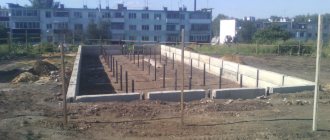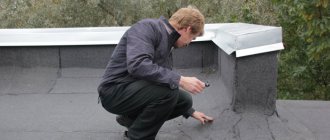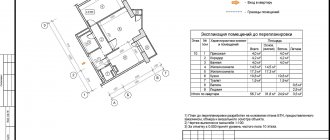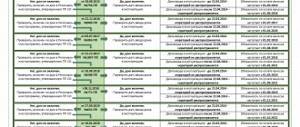What is included in current renovation work?
Routine repairs ensure that the property is maintained in proper operating condition. Within its framework, defects arising due to use or downtime are eliminated, and the functional and aesthetic qualities of the premises are improved. Activities of this level cannot include a complete replacement of the engineering equipment of the building or affect the supporting structures of the building.
Reference! if necessary, during ongoing repairs, limited restoration of individual parts of the structure is allowed - in an amount not exceeding 20% of the total volume of non-residential premises structures.
In accordance with Appendix No. 7 to Resolution of the State Construction Committee of the Russian Federation No. 170 dated September 27, 2003, the list of work carried out as part of routine repairs may include :
- eliminating damage and strengthening foundations;
- sealing and insulating wall joints and seams, sealing cracks, painting and repairing facades, restoring architectural elements, replacing wood wall cladding;
- replacement or restoration of elements of windows, doors, balconies, stairs, entrance canopies;
- repair of floors, replacement of floor and ceiling coverings, renewal of wall decoration;
- installation and replacement of internal communications elements and restoration of their functionality (sewage, water supply, electricity and gas supply);
- restoration of the functionality of the ventilation system and garbage chute.
In practice, routine repairs of non-residential premises, as a rule, include painting or pasting walls, patching floors, restoring doors and windows, eliminating communication defects (leaks, power failures, etc.), replacing consumables (for example, lighting fixtures).
Ongoing renovation work in commercial buildings
The purpose of routine repairs is to eliminate minor faults to maintain the normal functioning of the premises.
If such a need arises, during ongoing work it is allowed to repair individual parts of the structure, but not more than 20% of the total volume of the premises’ structures.
Current repairs have certain signs:
- Following the plan. It is drawn up several years in advance after inspecting the entire premises and taking inventory.
- Systematicity.
Repairs include:
- Reconstruction of flooring.
- Wall decoration.
- Replacement of consumables (lamps, faucets).
- Replacement or repair of doors.
- Systematic maintenance of utility networks and other minor works.
Overhaul - what is it?
Major repairs of non-residential premises involve carrying out a set of large-scale works that will prevent complete deterioration of the structure and ensure the functioning of its various systems for many years. Events of this level can be organized once every 10-20 years, their results remain effective for a long time. The need for major repairs depends on the actual wear and tear of the premises.
The list of works organized as part of a major overhaul is determined by amendments to the Town Planning Code introduced by Federal Law No. 215 of July 18, 2011. In accordance with them, the event must fulfill the following tasks:
- restore or replace components of the structure that have exhausted their resources (except for foundations, load-bearing walls and frames);
- ensure the modernization of the premises or redevelopment (if there is an economic justification for these actions);
- improve operational performance.
Reference! Overhaul can be selective or comprehensive. Its type determines the scale of the work carried out. In the first case, they cover the room partially, in the second - completely.
For example, a selective overhaul is a complete replacement of the plumbing system. Typically, a comprehensive overhaul includes eliminating damage to the roof, updating and strengthening supports and walls, restoring utilities, eliminating leaks, and landscaping the surrounding area.
What is included in the list of capital works in apartment buildings?
Major repairs are more serious changes compared to ongoing work; here actions pursue larger goals. They are aimed at providing the most comfortable conditions for high-quality results of industrial or production activities.
Major repair work includes:
- Restoration or replacement of building structures or elements of these structures.
- Restoration or replacement of engineering support systems or their elements.
- Restoration or replacement of individual elements of supporting structures for the purpose of improvement.
- Strengthening the supports and walls of the building.
- Repair of the surrounding area (sewer network, asphalt replacement).
Do property owners have to pay fees to maintain their property in good condition?
Owners are always responsible for the condition of their real estate, regardless of its purpose. The obligation to pay contributions for current or major repairs determines a number of individual characteristics of the premises.
In MKD
If we are talking about non-residential premises in an apartment building (hereinafter referred to as MKD), then the owner is obliged to pay monthly charges for current and major repairs (Part 2 of Article 154 of the Housing Code of the Russian Federation). The purpose of the property does not matter, since the funds will be used to maintain the condition of the entire house. The amount of accrual is distributed among property owners in accordance with the area of their premises.
Exceptions include apartment buildings that were put into operation in less than three to five years (depending on the region). In this case, fees for major repairs are possible only with the consent of all owners.
If the house is less than five years old, the property owner has not signed an agreement to pre-collect contributions for major repairs, but receives receipts, he should contact the local administration. Contributions for major repairs are not collected if a dilapidated house is designated for demolition .
In a private house or fund removed from the residential
Owners are not required to pay contributions for capital and current repairs in cases where non-residential real estate is located in a non-residential fund or as part of:
- a residential building containing less than four apartments, or a private single-family residential building, the residents of which are responsible for maintaining the building and the surrounding area;
- residential building, where the exits from the apartments lead to the street (there are no entrances or other common area.
Although they are not legally required to do this, if they wish, the owners of such properties can privately enter into agreements with a management company or contractor to carry out routine or major repairs.
Important! If a non-residential premises is the subject of a lease agreement, according to current legislation, its current repairs are borne by the tenant, while the landlord retains capital repairs.
Responsibility for carrying out ongoing repair work remains the responsibility of the owner-lessor only if his retention of such responsibilities is specified in the lease agreement (Civil Code, Part 2, Section 4, Chapter 34, Article 616).
Contributions for major repairs for owners of non-residential premises in apartment buildings
Private practicing lawyer, expert in legal support for the activities of housing and communal services organizations
especially for GARANT.RU
In housing legislation, there is a collective name for mandatory payments for owners - payment for residential premises and utilities. Because of this name, owners of non-residential premises in apartment buildings often become convinced that they are not obliged to pay such payments, in particular for major repairs, since they own non-residential premises. But this is not so - in case of non-payment, they risk becoming debtors. Let's look into the nuances of this mandatory payment, both for non-residential premises and for parking spaces.
Features of property maintenance in an apartment building
Non-residential premises in MKD are divided into two types:
- property of commercial organizations, most often located on the ground floor (shops, salons, other organizations);
- areas that are in common use by property owners in apartment buildings (auxiliary and technical premises: entrances, basements, underground parking, etc.).
The costs of maintenance and repair of commercial property are borne by the owner or legal entity operating in non-residential premises in an amount corresponding to the occupied space and metering data. The contract is concluded privately with the housing department and determines the list of utility services provided.
Repair and maintenance of common areas of apartment buildings are carried out by authorized organizations (we talked about what is considered public areas in apartment buildings and whether the owners of non-residential premises should pay for one-room rent, we talked about in this material). This could be a management company or a homeowners association (HOA).
If it is necessary to reconstruct a private non-residential premises in an apartment building, the costs are borne by the owner. When organizing reconstruction work, the owner is obliged to ensure that the rights of neighbors are respected. Some measures require the written consent of other owners of the building (for example, moving walls can damage the overall stability of the building; residents must give permission for such a procedure).
The procedure for organizing the reconstruction of non-residential premises in an apartment building:
- Conducting an examination to determine the risks and guarantees of the results of the work.
- Familiarization of MKD property owners with the results of the examination.
- Obtaining permission for reconstruction from the administration of the locality (accompanied by written consent of the residents to carry out the work).
Coordination of changes with the owners often occurs with the participation of the management company, which brings the issue up for general discussion and holds a vote. The decision is determined by a majority of votes. Similarly, coordination of the reconstruction of the common areas of apartment buildings is organized with the owners of non-residential premises. Modernization is possible only after receiving permission from the administration.
How are contributions determined?
The purpose of real estate located as part of an apartment building does not matter when paying contributions for major repairs. Owners of non-residential premises pay the costs of maintaining and repairing the house on an equal basis with the owners of residential premises (Article 39 of the Housing Code of the Russian Federation).
The costs of major repairs of apartment buildings, according to Article 158 of the Housing Code of the Russian Federation, are proportional to the payer’s personal share in the common property. They can be calculated based on the area of residential or non-residential premises occupied by the owner.
For example, the area of the owner’s private property is 50 m2. The cost of the monthly contribution for the overhaul of an apartment building per 1 m2 varies in different regions. In 2021, the minimum contribution of Muscovites for major repairs of 1 m2 is 15 rubles. We multiply 15 by 50 and get 750 rubles. This is exactly how much the owner in the example in Moscow will pay monthly.
The monthly contribution for major repairs of 1 m2 may exceed the minimum rate in the region if residents made such a decision by voting in which more than 50% of the owners took part, or if a differentiated rate is applied in the region for houses of different classes. The law determines only the minimum threshold and does not limit the maximum.
Since 2015, a line dedicated to major repairs has appeared in standard documents on payment of utility services. Contributions can be made during the usual procedure of monthly payment for property maintenance in the method that is most convenient for you (branches of banks and Russian post offices, ATMs, Internet services). It is enough to know the details for paying for housing and communal services .
The amount required for payment is provided to each resident in the form of receipts. If a payment document is lost or a debt arises for any other reason, a penalty will be charged. You can clarify the amount of payment to the capital repair fund, which will pay off the debt, in the following organizations:
- companies providing housing and communal services;
- management companies;
- central clearing offices.
The debt for contributions for major repairs and penalties must be repaid within three months . Otherwise, housing and communal services employees may suspend or completely stop providing utility services (water, gas, electricity) and subsequently go to court to collect the debt.
We recommend that all owners of non-residential premises read other publications on our website devoted to the use of such real estate, the nuances of its maintenance and payment of utilities:
- What is operational management and what is included in the concept of technical maintenance of such premises in apartment buildings?
- The nuances of paying for electricity, as well as how to properly organize heating, what are the temperature requirements and tariffs?
- Concluding an agreement with the cleaner.
- How to connect the Internet in such a room?
- What should an owner do in case of flooding?







